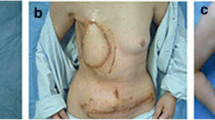Abstract.
Introduction: The prognosis of scar carcinoma, also known as Marjolin's ulcer, is poor. Metastases of lymph nodes often appear because of late diagnosis and the underestimation of clinical findings. This has a deep impact on the quality of life of the patients. Scar carcinoma often occurs in burn scars, but also in chronic ulcers of the lower extremities and in chronic pressure sores. Methods: Between 1994 and 1998 12 patients with scar carcinoma were treated at our hospital. In all cases radical surgery of the entire scar area was undertaken, followed by dissection of the draining lymph nodes. Free flaps, pendicular flaps or splint skin grafts were used to cover the resulting defects. Results: In 16.6 % we observed positive lymph nodes.There were two cases of local recurrence. Five patients died during the observation time. In one patient the extremity had to be amputated. Conclusion: Early diagnosis and radical excision are requirements, and the quality of life can be improved with plastic surgery. Aftercare and yearly staging measures are mandatory.
Zusammenfassung.
Einleitung: Das Plattenepithelcarcinom auf der Basis instabiler Narben (Narbencarcinom), auch als Marjolin-Ulcus bekannt, stellt eine Erkrankung mit schlechter Prognose dar. Häufig bestimmen durch späte Diagnostik und Unterschätzung des Befunds schon Lymphknotenmetastasen das weitere Schicksal der Patienten. Oftmals tritt es in Brandnarben, aber auch in chronischen Ulcerationen der unteren Extremitäten sowie in Decubitalulcera auf. Methoden: In unserer Klinik wurden 12 Patienten mit einem Narbencarcinom in den Jahren 1994–1998 behandelt. Bei allen Patienten erfolgte eine radikale Excision des gesamten Narbengewebes. Die entstandenen Defekte wurden durch freie mikrovasculäre Transplantate, durch lokale Lappen und Spalthaut gedeckt. Die Lymphadenektomie war obligat. Ergebnisse: In 16,6 % fanden wir positive Lymphknoten. Im Untersuchungszeitraum verstarben 5 Patienten. In 3 Fällen beobachteten wir ein lokales Rezidiv. Bei 2 Patienten war es nicht möglich, extremitätenerhaltend zu operieren. Schlußfolgerung: Eine frühzeitige Diagnostik und die radikale chirurgische Therapie sind unabdingbar. Durch plastisch-chirurgische Maßnahmen gelingt es, die Lebensqualität der Patienten zu verbessern. Folgen müssen eine engmaschige Nachsorge sowie jährliche Stagingmaßnahmen.
Similar content being viewed by others
Author information
Authors and Affiliations
Rights and permissions
About this article
Cite this article
Lenz, O., Plogmeier, K., Fansa, H. et al. Die chirurgische Behandlung des Narbencarcinoms – Methoden und Ergebnisse. Chirurg 72, 690–696 (2001). https://doi.org/10.1007/s001040170125
Issue Date:
DOI: https://doi.org/10.1007/s001040170125



